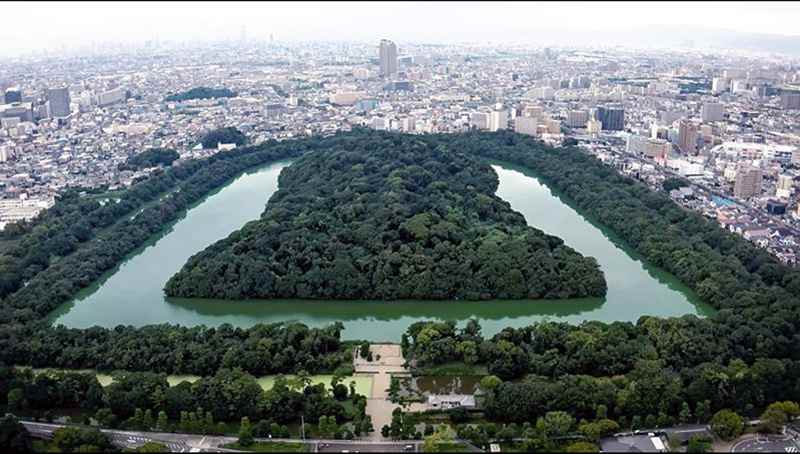
A moat around a mounded tomb reflects the morning sun.
12:52 JST, February 22, 2022
A group of kofun, ancient Japanese burial mounds known for often having a distinctive keyhole-shaped layout, is the subject of a high-definition 4K video capturing the tombs’ uniqueness and beauty.
The tombs of the Mozu-Furuichi Kofun Group comprise a World Heritage site in Osaka Prefecture, where local governments used drones and other equipment to make the four-minute video in a bid to promote tourism despite pandemic-related barriers to travel.
In the video, armchair travelers — and future real-life visitors — can feast their eyes on the enormous tree-covered mass of the Nintoku-tenno-ryo Kofun in the central part of the Mozu area in Sakai, with the modern cityscape spreading out all around it. It also shows the Gobyoyama Kofun in the same area, with its moat reflecting the ever-changing colors of the morning sky in a beautiful time-lapse sequence.

The Nintoku-tenno-ryo Kofun, keyhole-shaped burial mound, is seen in Sakai, Osaka.
Courtesy of the Mozu-Furuichi Kofun Group World Heritage Management Local Council
The Nintoku-tenno-ryo Kofun, keyhole-shaped burial mound, is seen in Sakai, Osaka.
Ojin-tenno-ryo Kofun in the central part of the Furuichi area in Habikino is shown with neighboring fields of figs, and farmers are seen harvesting the fruits.
Images such as the Sekimenyama Kofun — beneath an elevated highway in Fujiidera — illustrate the history of heritage left behind in the bustle of civic life and urban development.
There is no narration, but the persuasive visual power of the video is intended to convey the charm of the city to those in other countries.
The Mozu-Furuichi Kofun Group World Heritage Management Local Council, made up of the three local cities of Sakai, Habikino, and Fujiidera, and the Osaka prefectural government, filmed the video last summer.
The video is accompanied by a link to the website of the local council, which has texts in many languages including Chinese and Korean.
The person in charge of the project said, “We hope that the beauty of the video alone will surprise people from overseas and make them wonder, ‘Where the earth am I?’ We hope that this will help boost inbound tourism after the pandemic.”
The video, posted on YouTube early this month, can be viewed at https://youtu.be/MeMt4vuenZs.
"Society" POPULAR ARTICLE
-

M4.9 Earthquake Hits Tokyo, Neighboring Prefectures
-

Israeli Tourists Refused Accommodation at Hotel in Japan’s Nagano Pref., Prompting Protest by Israeli Embassy and Probe by Prefecture
-

M7.5 Earthquake Hits Northern Japan; Tsunami Waves Observed in Hokkaido, Aomori and Iwate Prefectures
-

Tsukiji Market Urges Tourists to Avoid Visiting in Year-End
-

High School in Kyoto Says Students Shoplifted during Recent School Trip to Bali, Indonesia
JN ACCESS RANKING
-

Tokyo Economic Security Forum to Hold Inaugural Meeting Amid Tense Global Environment
-

Keidanren Chairman Yoshinobu Tsutsui Visits Kashiwazaki-Kariwa Nuclear Power Plant; Inspects New Emergency Safety System
-

Imports of Rare Earths from China Facing Delays, May Be Caused by Deterioration of Japan-China Relations
-

University of Tokyo Professor Discusses Japanese Economic Security in Interview Ahead of Forum
-

Japan Pulls out of Vietnam Nuclear Project, Complicating Hanoi’s Power Plans

























